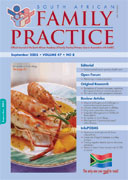Review: Management of Gastroesophageal Reflux Disease.
Abstract
The primary treatment goals in patients with gastroesophageal reflux disease are relief of symptoms, prevention of symptom relapse, healing of erosive oesophagitis, and prevention of complications of oesophagitis. In patients with reflux oesophagitis, treatment is directed at acid suppression through the use of lifestyle modifications (e.g., elevating the head of the bed, modifying the size and composition of meals) and pharmacologic agents (a histamine H2-receptor antagonist [H2RA] taken on demand or a proton pump inhibitor [PPI] taken 30 to 60 minutes before the first meal of the day). The preferred empiric approach is step-up therapy (treat initially with an H2RA for eight weeks; if symptoms do not improve, change to a PPI) or step-down therapy (treat initially with a PPI; then titrate to the lowest effective medication type and dosage). In patients with erosive oesophagitis identified on endoscopy, a PPI is the initial treatment of choice. Diagnostic testing should be reserved for patients who exhibit warning signs (i.e., weight loss, dysphagia, gastrointestinal bleeding) and patients who are at risk for complications of oesophagitis (i.e., esophageal stricture formation, Barrett's oesophagus, adenocarcinoma). Antireflux surgery, including open and laparoscopic versions of Nissen fundoplication, is an alternative treatment in patients who have chronic reflux with recalcitrant symptoms. Newer endoscopic modalities, including the Stretta and endocinch procedures, are less invasive and have fewer complications than antireflux surgery, but response rates are lower. (SA Fam Pract 2005;47(8): 49-54) (Reprinted with kind permission from the American Family Physician, 2003;68(7):1311-1318. Copyright © American Academy of Family Physicians) Permission from the AAFP was granted to publish this article in the hardcopy only. Kindly refer to www.aafp.org or subscribe to the hardcopy of South African Family Practice.
Published
2005-09-01
Section
Review Articles
By submitting manuscripts to SAFP, authors of original articles are assigning copyright to the South African Academy of Family Physicians. Copyright of review articles are assigned to the Publisher, Medpharm Publications (Pty) Ltd, unless otherwise specified. Authors may use their own work after publication without written permission, provided they acknowledge the original source. Individuals and academic institutions may freely copy and distribute articles published in SAFP for educational and research purposes without obtaining permission.

